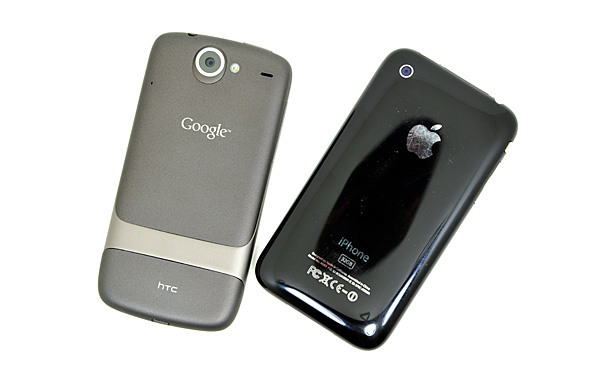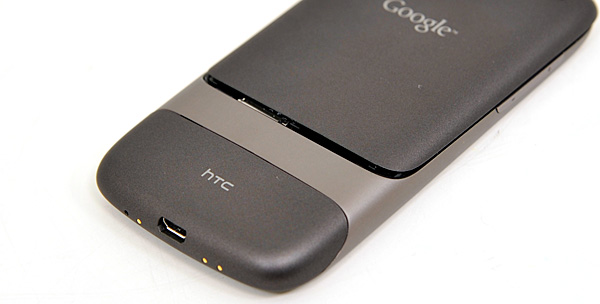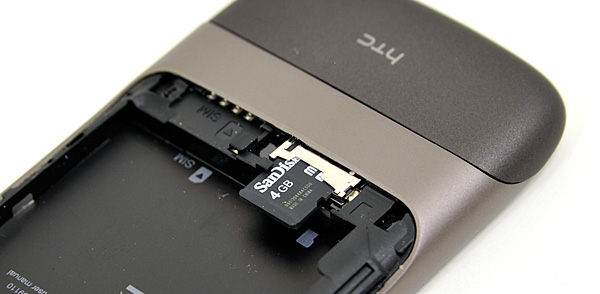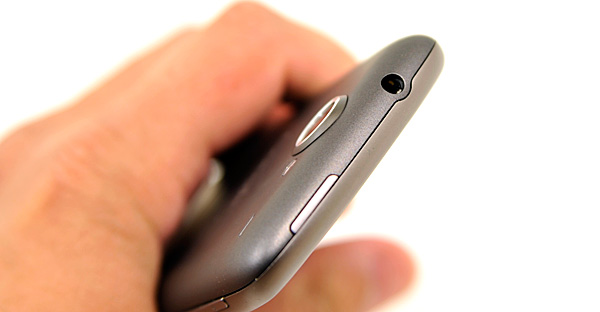Anand's Google Nexus One Review
by Anand Lal Shimpi on April 3, 2010 3:40 AM EST- Posted in
- Smartphones
- Mobile
Experiencing the Nexus, Without Whoopie
Announced in January 2010 and just updated last month to include support for AT&T's network, this is Google's Nexus One manufactured by HTC:

It's got a Qualcomm Snapdragon QSD8250 SoC (more on this later), 512MB LPDDR1, 512MB flash (where apps and the OS are stored), 4GB microSD card (for music/movies/photos) and boasts a 800 x 480 3.7" AMOLED screen.
The design is definitely not as cohesive as the iPhone, but here’s one area where Apple’s ID doesn’t really pay off - for a device that spends most of its life in your pocket, hand or next to your face - styling loses its value pretty quickly. The iPhone looks sleeker, but I’ll take the upgraded functionality of the Nexus One’s camera with flash any day.

The Nexus One is narrower, thinner but longer than the iPhone. The dimensions are as follows:
| Google Nexus One vs. Apple iPhone | |||||
|
Apple iPhone 3GS (ARM Cortex A8)
|
Google Nexus One (Qualcomm Snapdragon QSD8650)
|
||||
| Height | 115 mm (4.5") | 119 mm (4.7") | |||
| Width | 62.1 mm (2.44") | 59.8 mm (2.35") | |||
| Depth | 12.3 mm (0.48") | 11.5 mm (0.45") | |||
| Weight | 133 g (4.7 oz) | 130 g (4.6 oz) | |||
The form factor is both better and worse. Making the Nexus One thinner means that it’s more comfortable to hold up to your head as a phone. You don’t succumb to the iPhone conversation fatigue nearly as quickly. The downside is that the virtual keyboard is narrower, making typing more difficult than the already painful to learn (for some) iPhone keyboard. Personally, I don’t think the tradeoff is worth it. While I believe the Nexus One’s form factor is closer to ideal for carrying around, its keyboard (in portrait mode) is worse off because of it.

This is a normal smartphone after all, so you do get a removable battery. The back cover slides off to reveal a battery, micro SD card slot and SIM card slot. The removable battery is an important addition as you'll soon see. The Nexus One ships with a 4GB micro SD card from the factory.


Charging is done using a micro-B USB cable. Google provides one cable, one power adapter and a set of headphones in the box. The packaging is easily comparable to anything Apple ships. Even the plastic wrap around the cables feels soft to the touch.

You get a standard 1/8” headphone jack up top and to the left of it is your power/lock button. Initial boot on the Nexus One does take a while, I timed it at 48 seconds (that's PC-length!).

As with all other Android phones, you need a SIM and a Google account to make the Nexus One work. Simply typing in your existing Google/Gmail account works, or you can register through the phone’s interface. All syncing with the phone is done over the air and with Google’s servers.
Google doesn’t have a desktop OS (yet), and no thick client desktop apps. Rather than rely on building bridges between its smartphone OS and the desktop applications of its competitors, Google relies entirely on its cloud based services for syncing. Gmail, Google Contacts, Google Calendar, these are your new best friends. Already use all of them? Perfect - your Android phone syncs with your account and you’ll get all of your mail, contacts and calendar events immediately. If you don’t already use them then it’s a lane change. Not a difficult adjustment to make, but transitioning from desktop apps to something entirely cloud based does take some getting used to if you haven’t made the jump prior.










95 Comments
View All Comments
xtremevarun - Saturday, April 3, 2010 - link
Reviews of Nexus One on other sites were not as comprehensive as on Anandtech. You guys really explored all the features. Apple needs to do a major refresh to iPhone. And I do see Android becoming a major, major OS for phones if it's not already. WinMo7 also looks great. Good that competition is hotting up against the iPhone.xxNIBxx - Saturday, April 3, 2010 - link
What about Samsung's Bada OS? Samsung Wave s8500 beats the living crap out of all those Snapdragon devices. Also Samsung will release i9000 Galaxy S, which has pretty much the same hardware as with s8500, except it runs Android. Hardware wise, these 2 are the best phones in the world. Snapdragon is old news.Iphone 4g, which will come out in 2 months, will most likely use apple's a4, which from what i hear, is probably identical to samsung's 1ghz cpu(same cpu/gpu)/
sprockkets - Saturday, April 3, 2010 - link
If you receive a call over BT, does it1. Play the ringtone over the headset?
2. Play it on the headset only or both the speaker and headset?
3. Announce CID over the headset or even just the speaker?
sushantsharma - Saturday, April 3, 2010 - link
Looks OK! But usability should not go for a toss! Or I am missing it and it is there?Chloiber - Saturday, April 3, 2010 - link
"It's got a Qualcomm Snapdragon QSD8650 SoC"Thought the Nexus One (and the HTC Desire) use a Snapdragon QSD8250?!
Anand Lal Shimpi - Saturday, April 3, 2010 - link
You are correct :) Fixed!Take care,
Anand
Karl Brown - Saturday, April 3, 2010 - link
I will be receiving my Sony X10 on Tuesday.I hope the Sony will offer enough of the Nexus One's functionality to not make me regret not waiting longer for the Nexus One to become available in the UK.
jasperjones - Saturday, April 3, 2010 - link
Thanks for the very thorough review. The one area were the review lacks depth is audio and video playback and syncing. Differences in this area are striking imo:1.) If you don't use iTunes as an iPhone owner, you're pretty much SOL. The Nexus One I could sync with iTunes using DoubleTwist. But I don't like iTunes. I can just use Explorer or Windows Media Player or Songbird (1.7 beta) to sync instead. The latest Songbird builds do an amazing job (they even converts WAV and FLAC files on-the-fly).
2.) Formats. I like that the the Nexus One supports OGG. FLAC support is coming (AFAIK it got added to trunk some time ago--idk if users will see it in FroYo or Gingerbread) Plus the Nexus One gives me everything the iPhone has (including M4A).
3.) The media player. I hate to admit it as a current Nexus One and previous iPhone owner, but here the iPhone with its iPod app wins hands down. The UI of the iPod app is infinitely more intuitive, whereas things such as playlist generation are a pain on Android (everything takes far too many clicks).
Because of 3.), I think the overall win in this category goes to the iPhone.
bstewart - Saturday, April 3, 2010 - link
Outstanding review - really enjoyed your detailed assessment of the Nexus one compared to the IPone and Palm Pre. I have read a number of reviews on the Nexus one lately determining if it is the right device for me or not. After reading this review I am certainly more inclined to purchase it than before; especially based on it's pros and cons versus the IPhone. Thanks!Brian
cj100570 - Saturday, April 3, 2010 - link
All in all I'm not feeling this review. There was way to much time spent comparing the Nexus to the iPhone. And your complaints about the notification system used by Android is just asinine. I'm the former owner of both an original and 3G iPhone and Android simply puts the iPhone OS to shame. The iPhone had it's 15 minutes of fame but it's time to face facts that Apples way of doing things is the biggest problem the iPhone has. As a smartphone it is a #FAIL. Sure it sells well but the honest truth is that most people buy it because it's an Apple product and because of all the apps, 80% useless, that Apple and AT&T trot out as the big selling point.